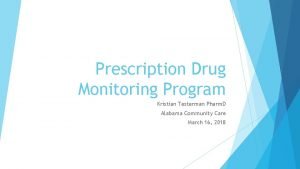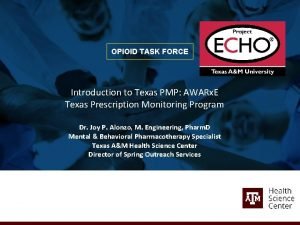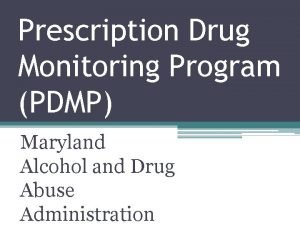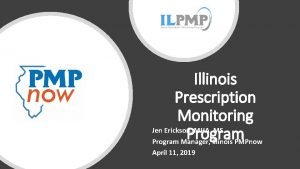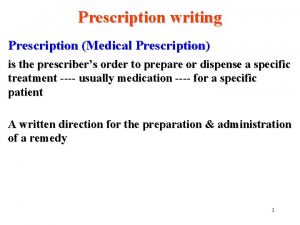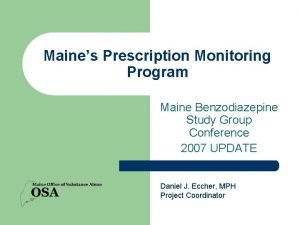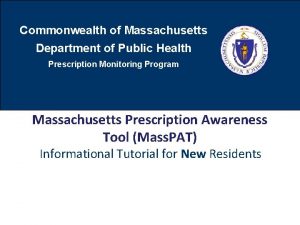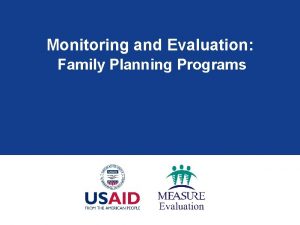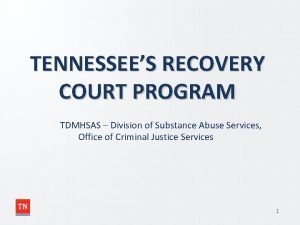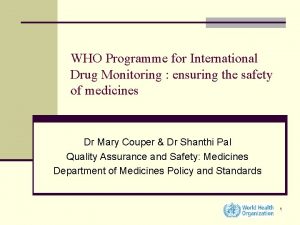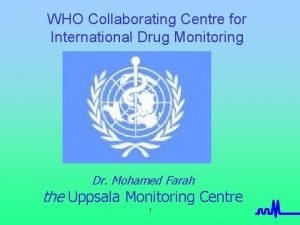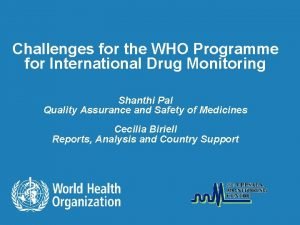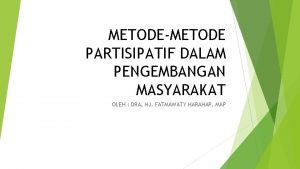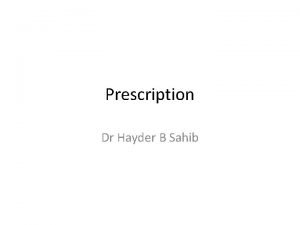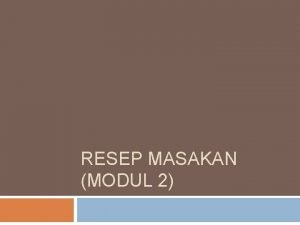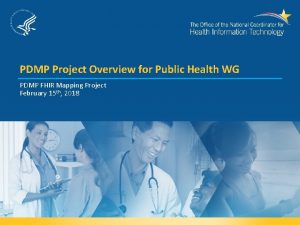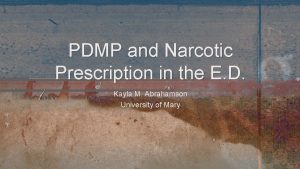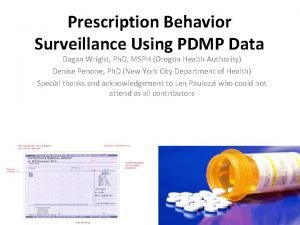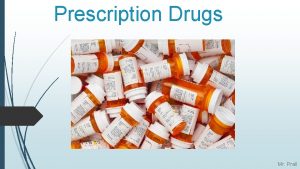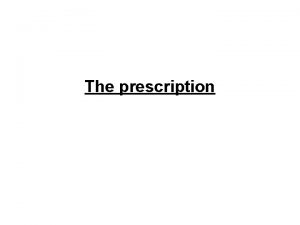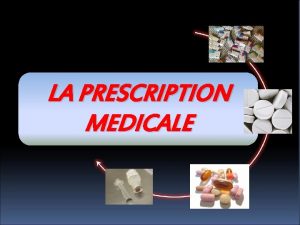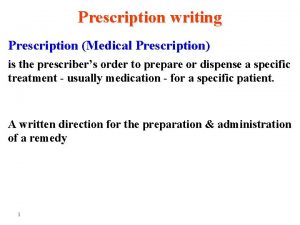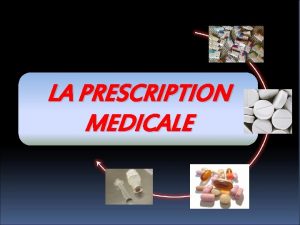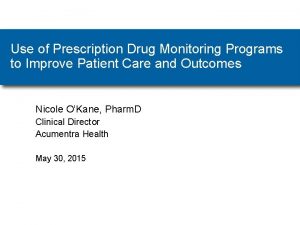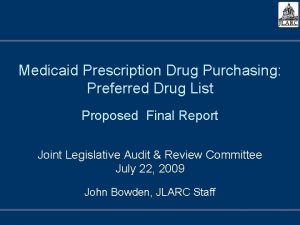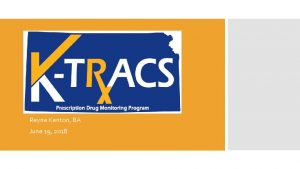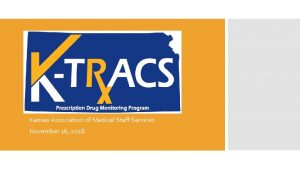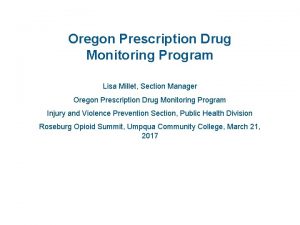PRESCRIPTION DRUG MONITORING PROGRAMS PDMP AND THE IMPACT


















































- Slides: 50

PRESCRIPTION DRUG MONITORING PROGRAMS (PDMP) AND THE IMPACT OF THE PROVIDER ON THE Whitnee Brown, CRNP, MSN Troy University Doctor of Nursing Practice Program

DISCLOSURE I have no financial relationships or affiliations to disclose. AND I will not discuss off label use and /or investigational use in my presentation.

WHAT YOU NEED TO KNOW BEFORE WE BEGIN There is 1 CME credit offered for this presentation. There is a research study associated with this presentation. You are not required to participate in the study, however if you have already agreed to participate your participation is appreciated. Designation of Credit Statement St. Vincent’s Hospital designates this educational live activity for a maximum of 1 AMA PRA Category 1 Credit(s)™. Physicians should only claim credit commensurate with the extent of their participation in the activity.

ACCORDING TO SAMHSA 2016 NATIONAL SURVEY ON DRUG USE AND HEALTH Ø 28. 6 million people used an illicit drug in the past 30 days. Ø 11. 8 million people (4. 4% of the population) misused opioids in the past year. ◦ 11. 5 million people are misusing pain relievers. ◦ 948, 000 people are heroin users.

ACCORDING TO SAMHSA 2016 NATIONAL SURVEY ON DRUG USE AND HEALTH Ø 7. 4 million people had an illicit drug use disorder. Ø 2. 1 million people had an opioid use disorder. ◦ 1. 8 million people with a prescription pain reliever use disorder. ◦ 0. 6 million people with a heroin use disorder.

2016 SAMHSA NATIONAL SURVEY ON DRUG USE AND HEALTH TOP REASONS FOR USING PRESCRIPTION PAIN MEDICATIONS Relieve Physical Pain - 62. 3% Feel Good or Get High - 12. 9% Relax or Relieve Tension - 10. 8% Help with Feelings or Emotions - 3. 9% Help with Sleep - 3. 3% Experiment - 3. 0% Hooked - 2. 0% Increase or Decrease Effects of Other Drugs - 0. 9% Some Other Reason - 0. 9%

2016 SAMHSA NATIONAL SURVEY ON DRUG USE AND HEALTH SOURCES FOR OBTAINING Friend or Relative (bought or PRESCRIPTION PAINFrom MEDICATION free) - 53. 0% Prescription From One Doctor 35. 4% Bought From Drug Dealer or Stranger - 6. 0% Some Other Way - 3. 4%

OPIOID PRESCRIBING RATES IN THE UNITED STATES IN 2013 PER CDC

OPIOID PRESCRIBING RATES IN THE UNITED STATES IN 2016 PER CDC

BUT THE RATES ARE DEECLINING ………

TOP 4 STATES FOR HIGHEST OPIOID PRESCRIBING RATES IN THE UNITED STATES 2016 124 119 114 109 104 99 94 Alabama Tennessee Mississippi 2016 Arkansas

2016 CDC – TOP 10 STATES OPIOID PRESCRIPTION RATE PER 100 PERSONS CDC, QUINTILESIMS TRANSACTIONAL DATA WAREHOUSE (TDW) 2006– 2016 STATE 2016 Prescriptions per 100 Persons Alabama 121 Arkansas 114. 6 Tennessee 107. 5 Mississippi 105. 6 Louisiana 98. 1 Oklahoma 97. 9 Kentucky 97. 2 West Virginia 96 South Carolina 89. 4 Michigan 84. 9

US PRESCRIBING COUNTIES FOR 2016 PER CDC

DRUG OVERDOSE DEATH BY RESIDENCE ALABAMA AND SELECTED COUNTIES, 2013 - 2015 XUEJUN SHEN, ADPH CENTER FOR HEALTH STATISTICS

BIRMINGHAM SURROUNDING COUNTIES PRESCRIBING RATES PER CDC FOR 2016 Bibb 97. 2 per 100 persons Blount county 56. 9 per 100 persons Chilton 120. 4 per 100 persons Jefferson 116. 7 per 100 persons St. Clair 114. 4 per 100 persons Shelby 100. 7 per 100 persons Walker 235. 4 per 100 persons CDC, 2017

2013 -2016 OVERDOSE DEATH OCCURRENCES IN ALABAMA Opioid Related Deaths 800 All Drug Overdose Deaths 671 700 741 720 576 600 500 400 323 260 300 268 159 100 0 2013 2014 2015 2016 The sharp increase from 2013 -2014 was mainly due to Heroin-related deaths. The sharp increase from 2015 -2016 was mainly due to Fentanyl-related deaths. * 2016 numbers are preliminary data.

PRESCRIPTION DRUG ABUSE Rx abuse has quickly become a top public health concern in the United States Every day, 44 people in the U. S. die from overdose of prescription painkillers (CDC, 2015) Alabama was the highest opioid prescribing state in the United States in 2016 (Mattson, 2017).

DIVERSION • “Drug diversion is the illegal distribution or abuse of prescription drugs for purposes not intended by the prescriber (for example: recreation, addiction, or financial gain). ” • Types of drug diversion: – – Doctor shopping Drug theft Illegal internet pharmacies Selling of Rx Drugs

ALABAMA’S OPIOID EPIDEMIC 21 C. F. R. § 1306 -Controlled substance prescriptions (CSPs) must be “issued for legitimate medical purposes by individual practitioners acting in the usual course of their professional practice” -Drug diversion can occur at any point.

PHARAMCIST • 21 C. F. R. § 1306 – Responsibility on pharmacists. – They must • investigate the validity of CSPs that raise red flags • resolve these red flags • refuse to dispense a CSP if the validity of the prescription cannot be verified. • Pharmacist may refuse to fill a prescription if – – filling it would be contrary to law, be against the best interest of the patient, aid or abet an addiction or habit, be contrary to the health and safety of the patient.

PHARMACIST 21 C. F. R. § 1306 Puts responsibility on pharmacists who fill the prescriptions. They must investigate the validity of CSPs that raise red flags, resolve these red flags, and ultimately exercise their professional judgment to refuse to dispense a CSP if the validity of the prescription cannot be verified. Pharmacists are equally responsible under the law and may be prosecuted for the dispensation of a CSP that was not issued for a legitimate reason. “Enforcement action against pharmacists is most likely to occur when pharmacists fail to exercise corresponding responsibility” (Cote, 2013)

HOW CAN I MAKE A DIFFERENCE UTILIZE THE RESOURCES Helpful clinical tips to impact opioid crisis -Be mindful of quantities dispensed. -Check patient’s PDMP profile before prescribing opioids. -Set management goals to pain. - Prescribe opioids only when the benefit outweighs the risk.

PDMP Improve clinical decision-making (PDMP Center for Excellence, 2014) Increase ability to detect prescription drug abuse and diversion (Fleming et al. , 2014) PDMPs may improve clinical decision-making through increased access to detailed patient drug histories for both prescribers and dispensers (PDMP Center for Excellence, 2014) Increased access to patient data facilitates pharmacists ability to detect prescription drug abuse and diversion (Fleming et al. , 2014)

DRIVING FORCES: THE COST OF SUBSTANCE ABUSE

PRESCRIPTION DRUG MONITORING PROGRAM UTILIZATION

WHAT IS THE PDMP? The PDMP is a surveillance resource that allows providers to monitor the medications a patient is prescribed while under their care. According to the National Alliance for Model State Drug Laws (NAMSDL), a PDMP is a statewide electronic database which collects designated data on substances dispensed in the state. Alabama’s PDMP is regulated by the Alabama Department of Public Health (ADPH)

PURPOSE • To provide a source of information for practitioners and pharmacists regarding the controlled substance usage of a patient • To reduce prescription drug abuse by providers and patients. • To reduce time and effort to explore leads as assess the merits of possible drug diversion cases. • To educate physicians, pharmacists, policy makers, law enforcement, and the public regarding diversion, abuse, and misuse of controlled substances

PDMP FEATURES Ø Law enforcement can electronically request prescriber and dispenser reports. Ø Changes in probable cause declaration for law enforcement. Ø Regulatory boards can track licensees’ history.

PDMP FEATURES Ø Practitioners can search their own Drug Enforcement Administration (DEA) number. Ø Physicians can monitor mid level practitioners and delegates. Ø Morphine equivalent dosage can be seen on practitioner and pharmacists query reports.

DELEGATES Ø Physicians can have up to three delegates if one of the three is a nurse practitioner. Otherwise they may have two. Ø No other discipline can have delegates. Ø Delegate will not have access until physician links their accounts, and physician must unlink accounts when delegate leaves the practice. Ø Delegate can be licensed or unlicensed. Ø Must choose Delegate as License Type when registering.

MONITORING Physicians can monitor PDMP activities of delegate (Search History Query). Ø Physicians can monitor PDMP activities of collaborating mid-level prescriber (Mid-Level Practitioners Query). Ø Prescribers can monitor prescriptions filled under their DEA number (Prescriber DEA Query). Prescribers are encouraged to periodically run this report. Ø

REPORTING REQUIREMENTS ØDispensers are required to report daily (business days) effective November 2014. ØVeterinarians are exempt from reporting effective August 2016. ØMethadone clinics are exempt from reporting per federal law.

WHO HAS ACCESS? Ø Certifying boards. Ø State licensed (with Alabama Controlled Substances Certificate Ø Ø Ø [ACSC]) practitioners (physicians, optometrists, podiatrists, veterinarians, and dentists). State licensed pharmacists. State licensed physician assistants with Qualified Alabama Controlled Substances Certificate (QACSC). State licensed certified nurse practitioners with QACSC.

WHO HAS ACCESS ? Ø State licensed nurse midwives with QACSC. Ø State, local, and federal law enforcement authorities (indirect access). Ø Medicaid Agency (for Medicaid recipients only). Ø Physician delegates.

WHO MUST REPORT AND WHAT IS REQUIRED TO BE REPORTED? All dispensers of controlled substances in Alabama are required to report to PDMP except methadone clinics (exempted by federal law), federal facilities, and veterinarians. Ø Dispensers include pharmacies, physicians, other practitioners licensed by an Alabama regulatory board. Ø The definition of dispensing is going out the door with or to the patient. Does not include controlled substance administered to a patient while in the practitioner’s office or on the premises of an inpatient hospital facility. Ø

IMPORTANT INFORMATION Ø When logged into the database, the system will automatically log out after 15 minutes of inactivity. Ø PDMP will be deleting old data. The database will contain 5 years plus current year. Ø Disclaimer. Prescription data is only as good as the data that is uploaded by the dispensers.

MISSING DATA Ø Only the Dispenser who submitted the information can change it. Ø Contact dispensing pharmacy when wrong DEA number was entered. If no results, contact the Alabama Board of Pharmacy. Ø Contact ADPH PDMP when a pharmacy is not reporting to the database.

HELPFUL HINTS Ø Choose “All” for gender. Ø Choose “Within one Year” under date of birth unless the name is common. Ø If name is common, carefully select patients in the pick list. Ø Leave zip code blank. Ø The wider the date range, the longer it will take the report to run.

HELPFUL HINTS Ø Entering the Social Security number can help find patients using different names. Ø Hyphenated names can be tricky. Using the Alias fields, enter each name as the last name. Ø When using Multiple State Query, the more states selected, the longer it will take the report to run. Ø Let ADPH know when the collaborating physician changes.

NEW SYSTEM: AWARXE (APPRISS HEALTH) Ø Username will be your email address. Must be unique. Update now if needed. Ø The user will be asked to add specialty and other missing information upon initial log in. Ø Introduction webinars are available.

QUARTERLY PRESCRIBING REPORTS Ø Prescriber Reports will be sent quarterly to all users who have prescribed a controlled substance in the previous 6 months (April 2018): ◦ Ranks prescribers among their peers. ◦ Compares prescribing behavior to red flag indicators- high doses, combo therapy, and treatment duration. ◦ Summarizes patient and prescription volumes. ◦ Provides information on potential prescriber and pharmacy shoppers.

WHAT CAN I DO TO DECREASE THE NUMBERS OF THE OPIOID CRISIS? Improving the way opioids are prescribed will ensure patients have access to safer, more effective chronic pain treatment while reducing opioid misuse, abuse, and overdose. Checking your state’s PDMP is an important step in safer prescribing of these drugs. Talk to your patient about the risks for respiratory depression and overdose. Consider offering to taper opioids as well as prescribing naloxone for patients taking 50 MME/day or more. Counsel your patient and coordinate care with their other prescribers to improve safety and discuss the need to obtain opioids from a single provider. Check the PDMP regularly and consider tapering or discontinuation of opioids if pattern continues. Whenever possible, avoid prescribing opioids and benzodiazepines concurrently. Communicate with other prescribers to prioritize patient goals and weigh risks of concurrent opioid and benzodiazepine use.

HOW TO REQUEST ACCESS Access the Alabama PDMP website at www. alabamapublichealth. org/pdmp and click on the PDMP Login.

FOR FURTHER ASSISTANCE PDMP Help Desk 1 -855 -925 -4767

HOMEPAGE >SELECT PRESCRIPTION DRUG

SELECT PDMP LOGIN

LOGIN>

QUERYING THE PDMP These are requirements, and failure to meet them could be deemed a violation of the rule. The RMS rule requires the following: • For 30 MME or less per day, use PDMP in a manner consistent with good clinical practice • For more than 30 MME per day, review PDMP at least two times per year and document use of REMS in medical record • For more than 90 MME per day*, review PDMP every time prescriptions are written, on the same day the prescriptions are written, and document use of REMs in medical record • *Cumulative of all prescriptions written on the same day

EXEMPTIONS The rule exempts the PDMP query requirements for controlled substances prescriptions written for: Nursing home patients Hospice patients, where the prescription indicates hospice on the physical prescription Treatment of active, malignant pain*, or Intra-operative care** In-hospital (in-patient orders) prescribing (PDMP query rule does apply to prescriptions written at discharge) *Active, malignant pain means active cancer pain; it does not include acute pain, chronic malignant (cancer) pain, or other chronic pain **Intra-operative care means c. s. ordered, administered, or prescribed and filled in a hospital in connection with a procedure; it does not include prescriptions written to go home with the patient.

THANK YOU FOR YOUR TIME
 Alabama prescription drug monitoring program
Alabama prescription drug monitoring program Pmp aware texas
Pmp aware texas Pdmp maryland
Pdmp maryland Prescription monitoring program illinois
Prescription monitoring program illinois Drug diversion best practices
Drug diversion best practices Parts of prescription
Parts of prescription Benzodiazepines
Benzodiazepines Masspat pmp
Masspat pmp Cpmcd full form
Cpmcd full form Monitoring and evaluation of family planning programs
Monitoring and evaluation of family planning programs Tennessee drug court programs
Tennessee drug court programs Exhausted drug
Exhausted drug Who program for international drug monitoring
Who program for international drug monitoring Pull out you've hit an artery
Pull out you've hit an artery Who programme for international drug monitoring
Who programme for international drug monitoring Participatory impact monitoring adalah
Participatory impact monitoring adalah Military time minutes
Military time minutes Makanan
Makanan Hình ảnh bộ gõ cơ thể búng tay
Hình ảnh bộ gõ cơ thể búng tay Frameset trong html5
Frameset trong html5 Bổ thể
Bổ thể Tỉ lệ cơ thể trẻ em
Tỉ lệ cơ thể trẻ em Chó sói
Chó sói Tư thế worm breton là gì
Tư thế worm breton là gì Chúa yêu trần thế
Chúa yêu trần thế Môn thể thao bắt đầu bằng chữ f
Môn thể thao bắt đầu bằng chữ f Thế nào là hệ số cao nhất
Thế nào là hệ số cao nhất Các châu lục và đại dương trên thế giới
Các châu lục và đại dương trên thế giới Công thức tính độ biến thiên đông lượng
Công thức tính độ biến thiên đông lượng Trời xanh đây là của chúng ta thể thơ
Trời xanh đây là của chúng ta thể thơ Mật thư anh em như thể tay chân
Mật thư anh em như thể tay chân Phép trừ bù
Phép trừ bù Phản ứng thế ankan
Phản ứng thế ankan Các châu lục và đại dương trên thế giới
Các châu lục và đại dương trên thế giới Thể thơ truyền thống
Thể thơ truyền thống Quá trình desamine hóa có thể tạo ra
Quá trình desamine hóa có thể tạo ra Một số thể thơ truyền thống
Một số thể thơ truyền thống Cái miệng xinh xinh thế chỉ nói điều hay thôi
Cái miệng xinh xinh thế chỉ nói điều hay thôi Vẽ hình chiếu vuông góc của vật thể sau
Vẽ hình chiếu vuông góc của vật thể sau Biện pháp chống mỏi cơ
Biện pháp chống mỏi cơ đặc điểm cơ thể của người tối cổ
đặc điểm cơ thể của người tối cổ Thứ tự các dấu thăng giáng ở hóa biểu
Thứ tự các dấu thăng giáng ở hóa biểu Vẽ hình chiếu đứng bằng cạnh của vật thể
Vẽ hình chiếu đứng bằng cạnh của vật thể Phối cảnh
Phối cảnh Thẻ vin
Thẻ vin đại từ thay thế
đại từ thay thế điện thế nghỉ
điện thế nghỉ Tư thế ngồi viết
Tư thế ngồi viết Diễn thế sinh thái là
Diễn thế sinh thái là Các loại đột biến cấu trúc nhiễm sắc thể
Các loại đột biến cấu trúc nhiễm sắc thể Thế nào là số nguyên tố
Thế nào là số nguyên tố
